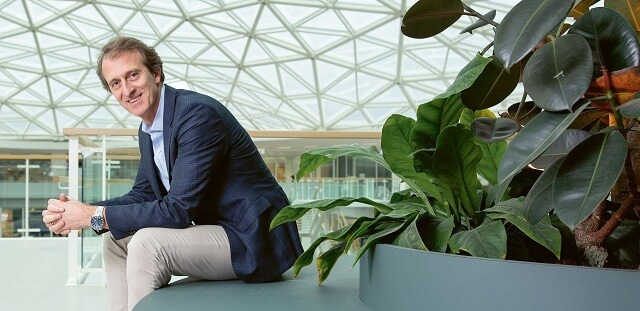Javier van Engelen (Signify) Sees a Broader Role for the CFO

11-04-2023 | Author: Jan Bletz | Image: Maartje Geels
Signify - the former Philips Lighting - has transformed itself and the lighting industry over the past decade by swapping traditional incandescent bulbs for energy-efficient LED lighting and smart lighting systems. LED-based lighting now accounts for 83 percent of the company’s total sales. The focus is now on smart, sustainable lighting solutions such as LiFi (wireless internet via light), UV-C air disinfection lighting, solar lighting, and lighting systems for horticulture. The move to LED lighting also created new opportunities for connectivity and smart control because it can be connected to other devices. For example, you can control an LED lamp with your smartphone and link it to sensors so that the lamp only turns on when people enter the space. Lighting infrastructure can also be used to measure air pollution, optimize traffic flow, and even contribute to increased street safety. LED lamps and luminaires, along with other devices, are therefore part of a larger ecosystem - and this creates new and far-reaching opportunities to collaborate with manufacturers, customers, and a variety of other parties.
All this means that Signify’s strength must lie primarily in the design of innovative lamps and related products, as well as in what at Signify are called systems and services, designed to make life more comfortable and businesses and cities more energy efficient. In the business market, accounting for about 70 percent of sales, the company is focusing on light as a service (LAAS): the fastest-growing arm within Signify, providing installation, maintenance, and end-of-life options, as well as fee-for-service financing solutions. The lights and other hardware are owned by Signify, so the longer the lifespan of the products, the better. And if something does fail, Signify will replace and recycle where possible.
This linkage to sensors and smart applications also contributes to data playing an increasingly important role. Based on the data the customer can access through the lighting infrastructure, the customer can create value beyond just lighting, or lower electricity costs. In offices, for example, smart lighting can assist building managers to make better use of floor space, when the data shows that certain meeting rooms are barely used while there is a shortage of desks to work at. And in cities, smart lighting allows municipalities to see via a centralized dashboard whether a light point needs to be replaced, where in the past each light point had to be inspected individually. In other words, Signify’s business model is strongly data-driven, with sustainability being one of its core values. Since 2020, the company has been carbon neutral, the culmination of the Brighter Lives, Better World program that ran from 2016 to 2020. Since then, the follow-up program has been in place (Brighter Lives, Better World 2025), with ambitious targets to double the positive impact on the environment and society: further reduction of the carbon footprint, higher ‘brighter lives revenues’ from products related to health, increase in ‘better world revenues’ from products that reduce material waste (circular revenues), and a further increase in gender diversity at management level. All things that CFO Javier van Engelen can talk about with enthusiasm: sustainability is not a ‘must’ for Signify, but is part of the company’s DNA, as he says. The relentless focus on sustainability has resulted in the company now leading the way. In Van Engelen’s words: we are ahead of the curve.
Similar to here at Signify, you often had IT as well as finance under your care in previous positions. Where does your personal passion lie?
‘I find it most rewarding to contribute to a company’s vision and strategy where it can have a positive impact on people and the planet. That is the most important thing. In a CFO function, it is very possible, since you have an overall view of all activities in the company, plus insight into all financial flow. A CFO therefore has a clear view of whether and how business operations need to be adjusted. An interface with IT is that nowadays you additionally have various information flows, which also provide an end-to-end picture of the company. Understanding financial and information flow leads to a better understanding of the business - the area of the CFO. That is why it is good that I manage both the financial and the digital domain. And even though I am foremost versed in finance, I can manage IT specialists by asking questions about how certain things can best be handled to contribute to the company’s goals. This also fits into my broader role as CFO. On the one hand, I am responsible for compliance with accounting and legal standards. This fiduciary responsibility is the foundation, as it is for every CFO. If that basis is in order, you can fulfill a second role: then you have earned the right to talk strategy and are allowed to add value as a director.’
And sustainability, is that also within your portfolio?
‘Within Signify, we have chosen to combine sustainability with other functions, particularly strategy, and place it in a department that reports directly to the CEO. Our chief sustainability & strategy officer is a member of the leadership team and ensures that sustainability is fully integrated into business strategy. Both IT and finance teams are working increasingly closer with sustainability, particularly as we prepare for a major new wave of ESG reporting standards.’
Just now you talked about the importance of digitization and data, for corporate policy in general and for sustainability policy. How is that organized?
‘Data is everywhere these days, and data is woven into every business unit. Our belief is that you must embed responsibility for data as much as possible in the teams themselves, with decentralized autonomy. We have a well-developed process model at Signify and have assigned the corresponding master data to it, so that it is clear what the right data source is and everyone is looking at the same version of the truth. The emphasis here is on data of critical importance, such as customer data, financial reporting, and sustainability. What exactly that data is and how exactly it is defined is up to specialists within the different departments: so, in addition to one data source, there is also one owner. For example, a product manager is responsible for product data.’
And if new attributes need to be added, for example because of tightened environmental laws?
‘Then the product manager must add the attributes defined by the sustainability team. In consultation with that team, of course. A next step is then reporting based on data - a layer on top of that data as it were. A big development we are facing in the data area is the extensive automation of this reporting process. Not only the calculations and aggregations need to meet the new reporting requirements, but also automated scans for the correctness of the underlying data. It must be done; the data streams are simply becoming too immense to manage with manual operations.
So, we do not have a chief data officer or other central data functions: we have several data product teams within different domains, each with its own expertise, with the ultimate responsibility with the quality team. All in all, this means that data quality is well assured, but also that it is necessary to coordinate between the different data domains often, more often than if everything had been centralized.
Apart from this, data securing is important, as part of cybersecurity - incidentally, something for which I am also ultimately responsible. Data securing is also partly decentralized. Especially when it comes to being compliant with the GDPR: to handle personal data confidentially, employees must be aware of what they can and cannot do with this kind of data. In this area, we work steadfastly with three lines of defense: the people on the shop floor are responsible for implementing the management guidelines and protocols, and in addition, all kinds of audits take place regularly.’
How does that work out in practice when it comes to sustainability data?
‘We generally have the data we need. Certainly, revenues from products that contribute to brighter lives and circular revenues are easier to measure, as are increases in gender diversity. The trickiest still is to get the right data on our carbon footprint: that requires an incredible amount of data and a loads of testing to validate it. From fiscal year 2024 we must comply with the new Corporate Sustainability Reporting Directive (CSRD), with all kinds of harmonized definitions as a basis. That means a great deal of work for us and many other companies, because we must bring our reporting process in line with the new requirements and because many diverse people have to learn to deal with them. That is going to work: I compare it to the introduction of a guideline like IFRS 16 or SOX: in the beginning it is an enormous amount of work, but once everything is in place, it becomes routine. And then sustainability reporting can become a valuable tool to evaluate and improve companies’ sustainability performance.
While I think the introduction of CSRD is a good development - it is only to be welcomed that companies are forced to take sustainability issues so seriously - I also have some concerns. Because, of course, Europe is only a microcosm. Will we not soon be at a competitive disadvantage compared to countries where companies have fewer obligations imposed on them and can therefore compete much more easily on price? You see in the fashion industry where that can lead: European companies often lose out to companies from low-wage countries. I hope that Europe succeeds in averting this danger. We ourselves cannot do much about it, except to continue on the path we have taken with our Brighter Lives Better World programs, help raise awareness about the importance of sustainability and show that sustainable does not necessarily mean expensive. Take our latest ultra-efficient A-class LED bulbs: they use 60 percent less electricity than previous-generation LED bulbs and over 90 percent less than a traditional incandescent bulb. Another example is that with lighting connected to sensors, you can save 20 to 30 percent in energy consumption, with which some companies have earned back their investment within a year. Lights that flash on when someone is nearby also add to a company’s security and to lower crime in public spaces. In short: we can emphasize the return on investment of sustainability.’
What else do you notice about sustainability?
‘Companies put too much emphasis on reporting and regulatory compliance, rather than on achieving sustainability goals. There is much talk about sustainability, but a little less action. Charles Jennings once developed the 70:20:10 model, saying that you learn the most - 70 percent - from doing things and the least - 10 percent - by learning formally. This plea against bookishness is poorly understood. 70 percent of all efforts now often go into unfolding all sorts of visions of sustainability, when by now the broad outlines of what needs to be done are clear. Twenty percent of the time is spent on how best to implement that vision. The remaining 10 percent is then spent on doing it. As far as I am concerned, the order should be exactly the other way around. There should be far more emphasis on activities that contribute to sustainability.’
This interview was published in Management Scope 04 2023.
This article was last changed on 11-04-2023

